
1999_1
Myriam Blais
Invention as a Celebration of Materials
"I'échange, c'est de tradition,
doit toujours s'accomplir au cours d'un festin"
(an exchange, as of tradition, always has to be performed
during a feast)
<Michel Serres Hermes I. La communication>
In the spirit of meaningful exchange suggested by Serres, this article explores the possibility of thinking about technology as a place for celebration.2 For that purpose, technology is defined here as the prudent use of techniques and implies a careful consideration of both thought and materials. This proposition relies on the sixteenth-century works of Françis Rabelais, doctor and novelist, and Philibert de l'Orme, architect, for their useful suggestions about providing a space for this celebration. Indeed, de l'Orme claimed to have contributed many beautiful and useful inventions to architecture, inventions that were supported by poetical illustrations relating to his interest in technology.3 Rabelais was a contemporary of de l'Orme and, although not an architect, was a privilege witness of the community of spirit that characterized their time. He also discussed architecture and technology through vivid images that help situate de l'Orme's ideas about invention in a larger context.
The first part of my
argument establishes the common grounds on which de
l'Orme and Rabelais conceived of invention in
architecture, especially by defining the "name"
and the way of working of the architect. The second part
studies specific images that illustrate their views of
invention through technology. The third part examines the
stories that de l'Orme developed to support the
legitimacy of his inventions. I will follow the thread of
these stories about invention as they celebrate
materials, the architect's "other" in the
production of a built work. Underlying all of this is the
relation that Rabelais and de l'Orme believed should
exist between their work and the people who will address
it: "In the art of architecture, undertakings of
buildings are made and pursued in hope of dwelling
commodiously and maintaining our health in them, of
taking pleasure from them and giving it to friends"
(PT, 7r).4
By introducing pleasure and friendship into the
realm of architecture, de l'Orme proposed that
architecture should be part of an ethical situation.
Relationships between buildings and people would resemble
relationships between people themselves; buildings would
be worth constructing if they constituted places for
exchange. Accordingly, de l'Orme and Rabelais developed
images of exchange and of creative encounter between
thought and materials, through technology. Like many
sixteenth-century French humanists, they faced an awkward
situation, inheriting a copiousness of ancient works in
their respective fields. To stimulate and legitimize
French architecture and literature, they believed they
had to determine which ancient topics were still
relevant, and then find a way to translate or reactivate
these materials to nourish future works.5 They
had to make a "virtuoso use" of ancient
sources.6 Virtuosity, in this sense, meant
that they needed to understand these topics fully before
they could produce images that would span the distance
between the original sources and newly invented works.
Copiousness (from the Latin copia, meaning
abundance, plenitude) was envisaged as part of a creative
approach to one's work. It prompted fruitful inventions
or new propositions to be found and woven together. It
also generated movements of knowledge as well as material
and sensuous expressions of this knowledge.7
In order to do so, copia had to be modelled after
nature, which multiplies and transforms itself in
abundance without ever repeating itself. In this way, copia-abundance
was clearly distinct from copia-copy (or
repetitive formal imitation). Copia-abundance
worked by allusions, playful associations, and analogies,
for "the feast of copious words or things [took]
place under the sign of fiction."8 This
was accomplished under the patronage of Hermes, an image
for the "richness of the carrier signs on which
depend[ed] the fecund reception of a thought."9
THE NAME OF THE ARCHITECT
De l'Orme and Hermes
De l'Orme's books have been regarded mainly as technical endeavours. Consequently, their illustrations, especially the striking presence of Hermes crowning both the Premier Tome de l'Architecture's frontispiece (Fig. 1.1 ) and one of the drawings of the architect (Fig. 1.2), have not been studied carefully in relation to de l'Orme's interest in materials. Considering his demand, stated at the beginning of the book, that one should understand "quel nom est Architecte" (what is the meaning of the name architect) (PT, 6v), Hermes indeed becomes a key figure.
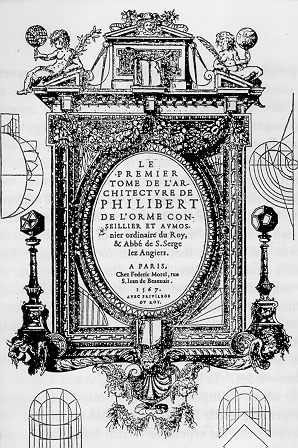
I.I Hermes, situated at the top of the frontispiece; from Philibert de l'Orme, Premier Tome de I'Architecture ( 1567) (Paris: Léonce Laget Librairie-Éditeur 1988).
Hermes generally has been presented as the gods' messenger and interpreter, the connection-maker, the friend of men in their everyday life the god of commerce, exchange, and metaphor. He represents the possibility of a creative relationship between different parties in an exchange. Hermes is especially relevant for technology, because his myth provides an alternative to that of Prometheus. Prometheus was responsible for bringing the arts to mankind by stealing the gods' fire. However, this theft did not go unpunished, since it had been triggered by his wish to compete with the gods. Nevertheless, Prometheus was the figure that man later chose to associate with technology. This inherited concept promoted a belief in unlimited progress and a freedom to trespass boundaries. Hermes's importance, for my argument, rests in the fact that he acknowledges and respects limits and boundaries, and that he is the communication link between their different sides.10
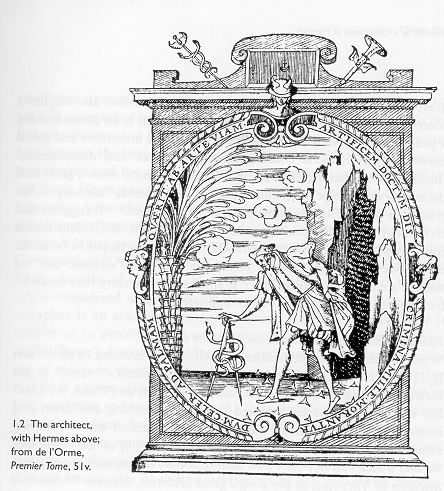
1.2 The architect, with Hermes above; from de l'Orme, Premier Tome, 5lv.
The idea of celebration
and feast characterises Hermes and runs throughout de
l'Orme's and Rabelais's works. It also implies that the
architect cultivates himself for this celebration. In
dealing with technology, the image of Hermes symbolizes
techniques being adapted, translated, or interpreted to
ensure that the encounter will please and celebrate both
parties. In this sense, de l'Orme and Rabelais are
concerned with the imaginative handling of distinct
materials through skillful work.
The skillful intelligence that guides Hermes's abilities
is called metis, a concept personified by the
Greek goddess Metis. This conjectural knowledge is an
"intellectual operation which lies half-way between
reasoning by analogy and a skill at deciphering the signs
which link what is visible to what is invisible."11
Metis is a manner of being in the world; an acute
eye and a skilful gesture enable an individual endowed
with metis to grasp a fleeting occasion and make
the best of it. Metis also implies a thorough
technical know-how. A person with metis is an
astute builder, a prudent craftsman who works to deliver
fruitful inventions and useful constructions. Metis
is enacted through gestures and demonstrated through
effects that arouse wonder.12 Moreover, metis
relies a great deal on memory to resolve a difficult
situation. In this sense, "memory makes possible a
passage to something different, a metaphor."13
It suggests that technology is much more than the
implementation of efficient means towards an end. Since
memory enables metaphors or tropes to be made, de
l'Orme's use of Hermes is consistent with the
"virtuoso use" of ancient sources mentioned
earlier. It emphasizes the story that an architect
invents to use his means in an appropriate way.
Rabelais and Messere Gaster; inventor of the arts
When Rabelais introduces
Gaster, the belly, as the inventor of all the arts (QL,
57-62), another interpretation of the architect's
"name" is put forward through Gaster's peculiar
association with de l'Orme. As Rabelais imagined it,
"Gaster invented the art of smashing and destroying
fortresses and castles, using engines and machines of war
- battering rams, stone hurlers, catapults, the figure
[drawing] of which he showed us,
and which had not been well understood by the ingenious
architects, disciples of Vitruvius, as the King's great
architect, Messere Philibert de l'Orme, once admitted to
us" (QL, 61) (my emphasis).
This excerpt from the Gaster story recalls a conversation
between the narrator and his fictional character, in
which the truth of Gaster's statement was confirmed by de
l'Orme. Rabelais used de l'Orme's opinion to account for
Gaster's, so that Gaster became a sound image of the
architect: Gaster and de l'Orme both understand what
architecture is, while many "ingenious architects,
disciples of Vitruvius" do not. A similarity is
established between the way Rabelais thinks of the
architect and the way an architect actually practises his
art. These images of the architect, through their
reciprocal collusion, acquire a mythical value.
Everybody, whether architect or not, can understand and
appreciate these exemplary images that illustrate and
define the "name" of the architect.
Like Hermes, Rabelais is cunning and artful in doing this
through wonderment. The fact - or rather the fiction -
that Gaster is a belly (in Greek, gaster means
either belly or womb, the seat of conception) establishes
a resemblance between different things: a belly and an
architect. This metaphor becomes a means of knowledge,
and the poet is the one who discovers or invents this
resemblance. Aristotle drew a comparison between the poet
(with the melancholic strength of his belly's inner
movements) and the archer (whose success depends on the
strength of his shot). He explained that the quality of a
metaphor depends on it being shot from afar with strength
and success. Hitting a target from this distance,
however, relies not on a law of ballistics but on a law
of poetics.14 It also provides a few
interpretations of the agreement between Gaster and de
l'Orme about the "figures" that were not well
understood by the disciples of Vitruvius. First, as I
have already suggested, technology is considered a
metaphorical, inventive, hermeneutical activity. A
metaphor is an act, since one has to shoot; it is also a
result, since it enables us to perceive what unites two
previously distant things. Secondly, Gaster's destruction
of fortresses anticipates the architect's wilful use of
ruins. In shooting from afar, the architect develops an
eye for making a virtuoso use of ruins, relying on an
architectural memory to find legitimate and worthy
topics. As these images demonstrate, invention is born
from those ruins or topics, which actually point to what
would be worth remembering. Thirdly, Gaster's devising of
engines and machines of destruction highlights the value
of one's material imagination, an imagination of depths
represented by the very act of destruction.15 This
suggests that the appearance of a thing should trigger
one's curiosity to know what is hidden within.
This last interpretation comes full circle and meets
again with the architect's metis as a producer of
effects that arouse wonder and invite an exchange.
Rabelais's Gaster story therefore suggests that the
fictional story concieved by the poet-architect
constitutes a conjectural truth, and that the physical
and intellectual circumstances from which a work of
architecture is born represent the very richness of
architecture: "Thinking leaves nothing tangible at
all. By itself, thinking never materializes into any
objects. To manifest one's thoughts, one must use his
hands. The thinker who wants the world to know the
'content' of his thoughts must first of all stop thinking
and remember his thoughts. Remembrance prepares the
intangible for its eventual materialization, it is the
beginning of the work process, its most immaterial
stage."16
Using one's hands (an analogue for technique) aims
to materialize thought. Techniques, and consequently the
thing made, "re-mind" us.17
It is up to the architect to look for techniques
and materials that will support his thoughts. If
techniques and materials exist for the sake of thought, a
built work will thus be judged by inquiring whether it
has been "both truly and well made."18
On the one hand, the truly made is a form of knowledge,
insofar as it is a conjectural manifestation of thought.
This knowledge is metaphorical, a figure of thought that
opens a new world. The well made, on the other hand,
represents the architect's crafty, witty, and metis-like
manner of working. The value of the truly and well made
lies in its pleasurable agreement between the architect's
ingenuity and the people who will address a work. The
images that support this ingenuity therefore may be part
of an ethical relationship. As the word edification
suggests, it is a question of responsibility to others in
constructing a building as well as oneself.19
IMAGES OF INVENTION
The body o f the architect, the elm tree and the vine
To illustrate the
"name" of the architect, de l'Orme invented a
new body for the architect by grafting extra body parts
(or senses of perception) and the wings of Hermes onto a
human body (Fig. 1.3). The graft is the mark of one's
material imagination, an imagination that gives life to a
material cause.20 An image that materializes
well, that fits well to the material it adorns, makes an
object's surface iridescent. Through it, one can
understand its depths.
Consider the architect's winged feet. They correspond to
Hermes's ability to fly, swiftly carrying himself from
one place to another. Importantly, the lower members of
the architect's body are what launch the flight. The
transport (or metaphor) that Hermes initiates thus comes
from a material foundation that is connected to the
ground by the soles of the feet. Poets conceived of the
wings of imagination as being located always at the feet.21
Those wings, whose technological image is the arrow
(along with the thrust that launches it), recall the
Aristotelian archer of metaphor. This provides another
interpretation of Gaster's and de l'Orme's ballistics of
poetry, which require a humoral movement that audacious
gestures convey.22 The body of the architect
manifests the exuberant experiences of his inner senses
and may be regarded as a gesture, a disclosure of meaning
within a world. Indeed, this gesture derives its
communicative force by being connected to the body, but
it
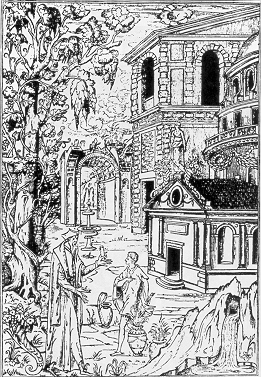
1.3 Drawing of the architect; from de l'Orme. Premier Tome, 283r.
achieves meaning by being
situated in a particular place.23 In this way,
de l'Orme also takes the opportunity to suggest a
relationship between the body of the architect and
building materials, exemplified by the elm tree standing
next to the architect. This suggests a play between the
almost homophonic French words "homme" (man)
and "orme" (elm tree), a play that would have
been common at the time of de l'Orme and Rabelais. The
tree was considered an image of man, and both have
provided the model for the column throughout the history
and theory of architecture (Fig. 1.4 & Fig. 1.5).
The architect's extra body parts and wings swirl around
the body, like the vine twisting and climbing around the
elm tree. Imagination and invention therefore are
supported by material, the material onto which a graft is
made. The body of the architect is another exemple of de
l'Orme's "virtuoso use" of an important
architectural topic - the human body. This body is then
rethought, through a metaphorical exercise, to produce a
new image: the elm tree and the vine that climbs around
it. Traditionally, in the cultivation of vines, the elm
tree served as a support for the vine which, in turn, had
to espouse the tree in order to grow.
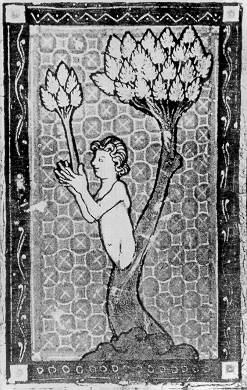
1.4 "D'un orme naît
un homme..." (A man is born from an elm tree);
from Imaginaire végétal de la procréation
(Paris. Bibl. Sainte Geneviève, ms 2000, XIII siècle,
172r).
This procedure required an appropriate pruning of both vine and tree so that neither would smother the other. Hermes again comes to mind as an image of plenitude between vine and tree, as well as between thought and material. Hermes stands in between, where technology (as an appropriate use of techniques) seeks an imaginative reactivation of inherited sources. De l'Orme's vine and elm tree espouse each other, in the space that both unites and distinguishes them. Like Hermes, who acknowledges and respects limits, the architect works to reconcile them. He must possess the sober drunkenness that colours the spirit so that the body may turn crimson. The vine's twisting around the elm tree thus acts like a trope; its garland-like decorating effect is an image of fullness that plays between thought and material. Images growing out from what supports
DE PHILIBERT DE L’ORME
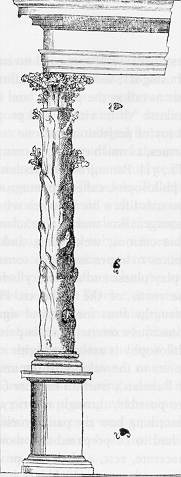
1.5 The tree-column; from de l'Orme, Premier Tome, 218r.
them, and their celebration of this support, are of great interest to de l'Orme and Rabelais; these images invoke the hermeneutical bounds and bonds within which invention keeps itself in check. The relation between appearance and technology is thus intricate. Appearance being the proof of existence, the architect's orderly use of techniques makes this appearance manifest, so that the evidence of a building; is not dissociated from the thought and the story that sustained its construction.
Rabelais's pantagruéllion: the kitchen, the table, the bed, and the body
At the end of his Tiers
Livre (49-52), Rabelais proposes another image, the
"pantagruélion," a magnificent plant named
after Pantagruel, the main character of his novels. It
was named this way for three reasons:
first, because "Pantagruel invented it: [not] the
plant, but a certain way of using it"; second,
"by similitude since Pantagruel, when he was born,
was as tall as the plant ... and its measure was easily
taken"; and third, because "of its virtues and
properties," for Pantagruel was the epitome oh
joyful perfection and one recognizes in the
pantagruélion "as many virtues, as much energy, as
many perfections, as many admirable effects" (TL,
51). Pantagruel is Rabelais's undisputed humanist hero.
He is given a philosophy, called
"pantagruélisme," which accounts for his
attitude towards life a life in which wisdom, virtue, and
pleasure come together. Pantagruelism makes an exchange
possible, and ensures it in advance. This curious,
welcoming, and understanding attitude, by which one
desires to appreciate truly someone else's intentions, is
characterized by a playfulness and a serenity before
unexpected events. This again recalls the metis of
the architect. Playing with life's surprises or nature's
strengths aims for cultural significance, not conquest
over them. The conscious exercise of art is part of that
adventure. Because Pantagruel's philosophy is associated
with it, the pantagruélion's soundness of name points to
the validity of the image Rabelais is proposing. It is an
image of Rabelais's truthful exercise of his art, and of
the variety of truths that are possible, through a
variety of manners and works of art.24 Before
describing how the pantagruélion got its name, Rabelais
explained how it had to be prepared and worked, how its
woody part slowly had to macerate, rest, and dry in
proper temperatures in order to obtains its fibres, its
most valuable and useful parts: "Those who really
want to bring out its value do the same as what we have
been told of the three Parcae sisters's pastime, of noble
Circe's nocturnal activity, and of Penelope's long excuse
to her gallant lovers during her husband's absence. In
this way, the plant is brought to its inestimable
virtues" (TL, 5o).
Rabelais uses the weaving metaphor to explain this
process; indeed, the Parcae sisters spin while singing,
Circe sings while weaving, and Penelope for the longest
time undoes at night what she has woven during the day.
In this way, Rabelais emphasizes the materiality of his
work and, most important, how to handle this material so
that its virtues, not its properties, are made manifest.
To unite the woof and the warp, or to weave, means to
intertwine opposites by putting everything in its proper
place. The textile object represents humanity’s
conscious decision making. Moreover, its very appearance
always recalls the act of weaving. A textile object also
combines the sensible or visible with the intelligible or
invisible. It wraps the body that feels and touches it,
while it displays a rigorous internal order. In a textile
object, ornamental motifs are not severed from their
support. Ornament and support appear together through the
same procedure, as if the motifs were already dwelling
within the woof. Consequently, the support is truly
privileged because it helps give form to what it bears.
The union of the woof and the warp suggests that there
are many possible interpretations (or actual textile
objects) that the warp allows the woof to generate.25
Therefore, Rabelais suggests, truthfulness to an art lies
in a patient exercise with materials; it is a truth
"to" materials and not a truth "of"
materials. Referring in this way to the labour of the
hands, Rabelais adds a subtle refinement to the realm of
technology, which our contemporary understanding seems to
have forgotten. Indeed, we usually think of a technique
as a savoir-faire, or know-how. For both Rabelais
and de l'Orme, it is more precisely a savoir s'y
prendre, or
know-how-to-handle-something-in-theright-way, with the
appropriate twist of hands and twist of thought. Savoir
s'y prendre has connotations of complete understanding.26
It is to know how to cling to whatever one wants to
understand; savoir s'y prendre suggests perfect
grasping. De l'Orme's vine twisting around the elm tree
is also an image of this idea: a proper pruning of the
vine of imagination is necessary to avoid smothering the
tree, and an equally adequate pruning of the tree is
needed if the vine is to bear fruit at all. The vine's
fate is tied to the tree's, and vice versa.
Through the image of the pantagruélion, Rabelais exposes
the underlying scaffolding of his work: "Without it,
kitchens would be ignoble and tables unpleasant even when
covered with exquisite meats; beds would be without
delights although there was gold, silver amber, ivory and
prophyry in abundance. Without it, would not the noble
art of printing perish? With it, priests are dressed and
adorned, and the whole of human nature is covered"
(TL, 51 ) (my emphasis).
Rabelais enumerates specific objects relating to basic
human activities. He then encompasses the whole of human
nature which, as a result of the pantagruélion, has been
covered in the first place. An architect's true exercise
of his art covers, adorns, and dresses nature - but not
literally, as a camouflage does. The Rabelaisian text
suggests that the value and utility of work rest on
"a rhetoric conceived as a clothing or an ornament,
not as a disguise and a lie."27 The
relationship that the pantagruélion makes possible
between eating and the tablecloth, between sleeping and
bedsheets, between language and paper, and between a body
and its clothes, is one of celebration. Tablecloths,
bedsheets, paper, and clothes establish a space oh
contact and exchange, suggesting that a meaningful
communication is impossible without that space. Although
Rabelais does not name or even describe these artifacts
per se, they nevertheless come to mind very vividly as
images of the virtues that the true exercise of an art
will allow. By the same token, an equivalency of form and
content is established between Pantagruel's philosophy
and the constructed objects that provide an image of it,
like a textile that recalls the act of weaving.
At the end of the same episode, Rabelais writes: "By
means of this plant, invisible substances are stopped and
detained visibly" (TL, 51). He does not merely
describe how, for example, wind caught by sails or
windmills can put a ship and a mill to work, the message
being that technology permits an easier and more
enjoyable life. There are deeper implications of the fact
that invisible things are made visible because of the
pantagruélion. For Rabelais, wind (and wine, the two
words in French, vent and vin, being
homophonic) is a symbol of imagination, hence of thought.
In the true exercise of an art, "a rhetoric
conceived as a clothing," a surface of contact or a
resemblance must exist between the clothing and the thing
that is clothed. What is thus made visible are the ways
in which the architect's imagination appears.28
This is nicely summarized by Michel Serres: "The
interior of matter, as soon as one ouvre it (I
conjuguate this verb as both to open and to work) becomes
an exterior."29 The pantagruélion story,
after all, may be an apology for technology, but only if
technology is conceived as the thoughtful consideration
of techniques. When techniques become a means to grasp
things and to take the measure of the mind, they open
myriad worlds that not only add to the natural one but
also cover it, so that a culture may be made manifest.
The ICONOGRAPHY AND TECHNOLOGY OF WOOD AND STONE
The wooden inventions
In 1561 de l'Orme published his Nouvelles Invention pour bien bastir et à petits fraiz, a treatise describing the manners he devised for building roofs, vaults, and floors out of small pieces of wood. De l'Orme claimed that these new wooden constructions (Fig. 1.6), born from a desire to
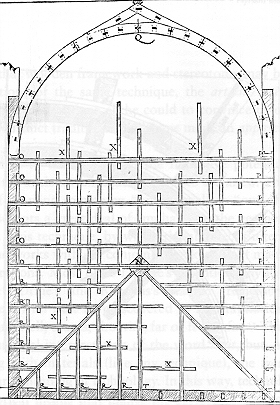
1.6a Examples of wooden inventions; from de l'Orme, Nouvelles Inventions (1561),
11 v. Paris: Léonce Laget 1988).
cover large
spaces despite a scarcity of large trees, were of his own
invention: "I believe that ancient architects never
thought of making such great-spanned roofs and other
incredible works by means of the invention I am
describing here: at least, there is nothing about it in
our books on architecture" (NI, 34v).
We are familiar with the commonplace that an invention is
born from desire and/or necessity. However, considering
how de l'Orme constructed his material images (congruent
with Rabelais' own poetic exercises), and considering the
intentions underlying the production of his works (so
that pleasure be both given and taken from them), one
should examine his inventions with these two aspects in
mind. As de l'Orme explains, "ancient people would
have taken great pleasure in being able to cover their
theaters and amphitheaters [with this invention]. They
used to cover them with cloth or other things, so that
the sun would not hurt people" (NI, 34r).
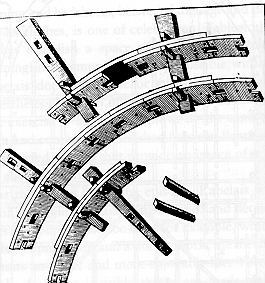
1.6b Examples of wooden inventions; from de l'Orme. Nouvelles Inventions (1561), 1Ov & 11v. Paris: Léonce Lager 1988).
Like Rabelais
before him, de l'Orme turns his invention into an
analogue of cloth. It is expressed rather plainly,
recalling almost literally one of the uses that Rabelais
had already assigned to his pantagruélion, "to
cover theatres and amphitheatres against heat" (TL,
51). Rabelais's and de l'Orme's previous agreement an a
viable way of thinking about invention is now evoked with
the latter's process of invention, as an instance of the
architect's true exercise of architecture. De l'Orme goes
on to add that "one can use this invention as one
does with stonework. There is no work or figure that this
invention cannot do as long as one understands the
traits. Because wood, according to its nature, has to
behave in a different manner than stone" (NI, 298r).
De l'Orme's wooden inventions are the result of applying
stone stereotomy - the trait - to wood. However,
this has another implication. By reusing a technique
known for another material, de l'Orme demonstrates how a
careful use of techniques enables a material to behave
differently without suppressing its inherent nature.
Different materials may be turned, through techniques,
into similar architectural elements, according to a
familiar image. His use of a well-known medieval
technique is significant: "it is true that wooden
framework and stereotomy may be regarded as
transformations of the same technique, the art du
trait. Would one say it had not Philibert done all he
could to convince us of it? Wood and stone have distinct
traditions. De l'Orme made an appareil out of
framework."30
De l'Orme indeed aimed to convince us of the
figurative potential (through an appareil) of the
ancient technique he chose to use anew. The art du
trait is the art of drawing something "on"
as well as "out of" materials. De l'Orme also
puts a great deal of emphasis on the geometrical aspect
of the traits. This technique, by which the
architect's intentions and the materials he works with
are conjoined, makes use of many learned geometrical
operations. Most of de l'Orme's inventions involve them.
Moreover, in de l'Orme's and Rabelais's manner (remember
Hermes and Gaster), the art du trait is
rediscovered as a metaphorical activity: the art of
shooting well, that is, shooting far or from afar.31
This may look like a circumstantial interpretation of the
word trait, but, as a technique for working with
materials (like any technique), the trait points
to the real value and meaning of technology. In this way,
technology becomes a metaphorical means that makes the
surface of contact and the resemblance between different
things perceptible. In a sense, the geometrical aspect of
the trait is equivalent to its metaphorical
aspect.32 Consider again the vine growing
around the elm tree; to know the material's pleats and to
grasp them leads to covering and celebrating them.
De l'Orme's colomne Françoise
In his Premier Tome de l'architecture (1567), de l'Orme introduces yet another invention: a colomne françoise (a French order), or a stone column "extracted from tree trunks" (PT, 217r). This invention again shows how de l'Orme works to maintain the iconography of a wellknown architectural element as it is translated from one material into another. This brings to mind Vitruvius's account about stone temples replacing Greek wooden temples. De l'Orme acknowledges that this way of thinking and doing is still relevant for his own practice of architecture, more than fifteen centuries after Vitruvius. With regard to his own invention, he explains that, when ancient architects built tree-columns, they wrapped metal bands around them to prevent cracking and split ting. After realizing that plants and leaves were growing between the
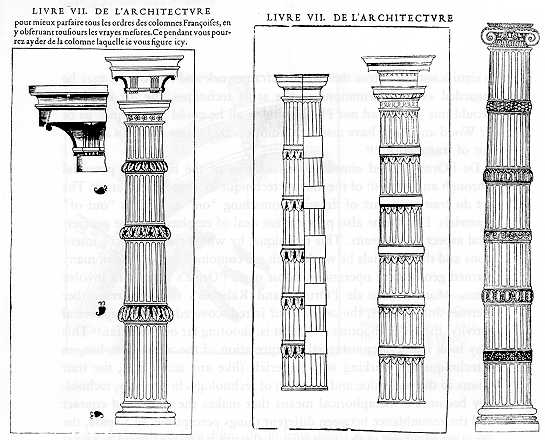
1.7 The "colomne Françoise"; from de l'Orme, Premier Tome, 219v, 220v, & 221 r.
column and
the metal bands, they carefully imitated this natural
process, inventing ornamentation for stone columns by
carving leaves in the same fashion. Similarly, de l'Orme
sets out to emulate nature's copiousness when devising a
French order appropriate for French architecture.
De l'Orme's colomne Françoise was also born from
necessity. Since it was difficult in France at the time
to construct one-piece columns, he had to make them out
of four or five stacked pieces, with carved ornaments
hiding the joints. They appeared to be one piece,
resembling the ancient wood columns with metal braces
(Fig. 1.7). It has been argued that de l'Orme's banded
columns were not really new, because similar Roman
examples already existed and de l'Orme probably knew
about them.33 Therefore, the construction of
column shafts out of small stones hardly seems to qualify
as an invention. Like his wooden frame inventions,
however, it is a meditation on technology's contribution
to his art. Indeed, he believes that "architects who
understand art and have great experience at it will find
an infinity of beautiful inventions, especially when they
are willing to take their topics from the nature of
places, as our predecessors did: I mean the imitation of
natural things, of their effect, and of Nature's
processes" (PT, ZI 9r).
While de l'Orme stresses that this invention imitates
both ancient architects' manners and nature's processes
(not merely copying their forms), his images also
illustrate nature's need to be triggered by art. Remember
the architect's body and the elm tree with its vine.
Indeed, what would have been nature's contribution had it
not been for the metal bands? De l'Orme, like Rabelais,
suggests that there is an important architectural
difference between the nature of materials and the
celebration of materials. If metal bands are wrapped
around tree-columns to prevent cracking, this seems to
respond to the nature of wood. Since de I'Orme wants his
many-pieced stone columns to look like the original
one-piece banded wooden column, he aims to recall what
they actually stood for. His stone columns are true to
wood while they celebrate stone. They have been seen as a
more viable type of column for French buildings because
they acknowledge the nature of their supports, the small
French stones.34 However true this statement may
be, it fails to give a full appreciation of de l'Orme's
contribution. More than a viable building element, his
colomne Francoise demonstrates a viable manner of
invention and the logic and imagination that de I'Orme
achieved when faced with both necessity and ancient
architectural topics.
De l'Orme marvels at how nature blooms in strange places;
he delights in anticipating, yet being surprised by, what
art generates through imagination. By translating an
architectural topic - the column - from wood into stone,
he celebrates it as his own invention. This manner of
working, a virtuoso use of inherited sources, had already
brought forth his wooden-frame inventions. This does not
mean that different materials are easily interchangeable.
As with Rabelais's pantagruélion, it is through a
thoughtful use of techniques that a material's woody part
(its apparent crust) is macerated to obtain its most
precious fibers (its virtues). De I'Orme's work with
resemblances between wood and stone searches for
intermediary images and surfaces of contact between
original topics and new circumstances. This geometrical
activity extracts measures from an original architectural
topic and from an original building material. The
appearance of ornament recalls the original process that
is being reinvented. Like the textile object that recalls
the art of weaving, the woof is a contingent
interpretation of the unchanging aspect of the warp.
While acknowledging the inherent duality between thought
and the nature of materials, an architect's inventions
should turn this duality into a celebration. Materials
may thus be seen as a legitimate support for thought,
through technology. De I'Orme's art du trait has been
defined as the "offspring of a misalliance between
geometry and technique, which for a long time, was held
to be a little contemptible." 35. As
with all unlikely unions, the offspring - a grotesque
body - is an image of the place where cultural
significance is expressed. Because the grotesque body is
in imaginary motion, it is the place of ingenuity, at the
crossroads of imaginative thought and material reality.
Since it is inscribed within the ethics of strange
alliances, de l'Orme's technology is the revelation of
the distance and the tension that exist between thought
and materials. Yet it provides for a way to reconcile
them.
Conceived in this way, invention does not belong to the space of conquest but to the space of celebration. If architecture is to be a celebration, architects must pay attention to the techniques they use and to all the elements entering their "cuisine." The architect has to be at work in the kitchen, where the banquet is being planned and where Hermes is no stranger, for this god is also the inventor of fire, the element that binds and cements all mixes, and is the source of meaningful smells.36 De l'Orme's and Rabelais' images for architecture imply that fecund encounters develop between an architect and materials, and later between a work of architecture and the people who will address it. It might be useful to wonder again about the current meaning of this "name" architect, especially with regard to the ethical, hermeneutical, and interpretive roles that de l'Orme and Rabelais once assigned to technology. The vine's and the elm tree's fates are still tied together.
Notes
1) I am
grateful to Alberto Perez-Gomez and to Stephen Parcell
for their careful reading of this work and their
judicious comments.
2) Celebration is understood as the repeated, renewed, or
even reinvented manifestation of things believed to be
worth remembering.
3) See my "Enhanced Architectural Making: The Ideas
and Works of Francois Rabelais and Philibert de
I'Orme" (University of Pennsylvania, PhD
dissertation 1994).
4) All translations of quotations from de I'Orme's and
Rabelais's works are mine. For easier notation, the
following references to de I'Orme's books are
established: the Nouvelles Inventions pour bien bastir et
à petits fraiz.(1561): NI, and the Premier Tome de
l'architecture ( 1567 ): they are specified by folio,
recto, or verso: Philibert de I'Orme, Traités
d'architecture. Nouvelles Inventions pour bien bastir et
à petits fraiz (1561), Premier Tome de l'architecture
(1567) (Paris: Leonce Laget Librairie-Editeur 1988). As
for François Rahelais's books: the Tiers Livre ( 1546):
TL, and the Quart Livre (1552): QL; in Rabelais's case,
references are given by chapters: François Rabelais, Oeuvres
completes (Paris: Editions du Seuil 'Intégrale 1973)
5) Michel Jeanneret, A Feast of Words. Banquets and Table
Talk in the Renaissance (Chicago: University of Chicago
Press 1991), 173.
6) Terence Cave, "Copia and Cornucopia," French
Renaissance Studies 154o- 70. Humanism and the
Encyclopedia, ed. Peter Sharrat (Edinburgh: Edinburgh
University Press 1976), 52.
7) Terence Cave, The Cornucopia Text (Oxford, U.K.:
Clarendon Press 1979), 3-34 and 171-82.
8) Ibid., 31-2.
9) Guillaume Budé, L'étude de lettres (1532). French
Renaissance humanists have attributed to Hermes the
all-encompassing image of humanism. He was the medium of
language and eloquence and represented the figures of
rhetoric that carried a thought.
10) On the relevance of Hermes for contemporary culture
and technology, see Michel Serres, Les cinq sens (Paris:
Grasset 1985), and Gilbert Durand, "Le nouvel esprit
anthropologique ou le retour d'Hermes," in Science
de I'homme et tradition. Le nouvel esprit antropologique
(Paris: Editions Sirac 1975), 227-43.
11) Marcel Détienne and Jean-Pierre Vernant, Cunning
Intelligence in Greek Culture and Society
(Chicago:University of Ghicago Press 1991), 314.
Additional references to Hermes and/or metis can be found
in Laurence Kahn, Hermes passe ou Ies ambiguites de la
communication (Paris: Maspero 1978), and Michel de
Certeau, L'invention du quotidien. Arts the faire (Paris:
Gallimard 1990).
12) Kahn, Hermes passe,82-3.
13) de Certeau, l'invention du quotidien, 126.
14) Jackie Pigeaud,"Une physiologie de I'inspiration
poétique. De I'humeur au trope," Etudes classiques
46, no. 1, (1978 ): 23-31.
15) Gaston Bachelard, L'eau et les rêves. Essai sur
I'imagination de la matiêre (Paris: Jose Corti 1942).
16) Hannah Arendt, The Human Condition (Chicago:
University of Chicago Press 1958), 9o.
17) A. Coomaraswamy, "A Figure of Specch or a Figure
of Thought ?" Coomaraswamy. Selected papers.
Metaphysics (Princeton: Princeton University Press 1977),
13-42
18) Ibid.
19) Edification consists of "the disciplined
expansion and ornamentation of interiority" (a
definition given by lvan lllich during a lecture at the
ACSA Northwest Regional Meeting in Philadelphia on 18
October 1991, under the title "Needs, Professions
and Places"). Its Manifestation becomes perceptible
in one's or something's appearance. Consequently, an
appearance is an expression of order, "conspicuous
and present in sensucus abundance" (Dalibor Vesely,
"Architecrure and the Poetics of
Representation," Daidalos 25 [1987], 29).
20) Bachelard, L'eau et Ies rêves, 1-28.
21) Gilbert Durand, Les structures anthropologiques de
I'imaginaire (Paris: Presses Universitaires de France
1963), 133.
22) Ibid.,166.
23) The four ears and hands of the architect are
attributes of wisdom, which is attained by practising a
trade (signified by the hands) and pondering other
people's counsels (signified by the cars). Wisdom
concerns man in his concrete relationship with others and
with nature. The three eyes of the architect represent an
interpretation of prudence, since it relies on memory and
Iearning from the past, intelligence in ordering the
present, and foresight in anticipating the future.
Through prudence, art becomes the paradigm of virtuous
actions since it produces tangible things. We obtain
virtues and arts by exercising them, and learn by doing
them. Since it accounts for a space and a time (the right
space and the right moment), prudence resembles the
conjectural thinking, the metis of a practical mind.
24) I owe part of this interpretation to Yves Délègue,
"Le Pantagruélion, ou Ie discours de la
vérité," Réforme, Humanisme, Renaissance 16
(1983) 18-4o. In most articles and books concerned with
the pantagruélion episode, the authors attempt to find
out which real plant Rabelais is, talking about and
ultimately interpret it as a mere praise of human work
and progress. This literal approach does not do justice
to Rabelais,s pantagruelism. Délègue's article
demonstrates an interesting concern with Rabelais's
manner of exercising his art.
25) John Scheid and Jesper Svembro, le métier è tisser
de Zeus. Mythe du tissage et du issu dans Ie monde
gréco-romain (Paris: Éditions la découverte 1994); and
François Dagognet, Rematérialiser. Matières et
matérialisme Paris: Vrin 1989)
26) The Latin prehendere means "to grasp" with
one's hands and thought, as is implied by the verbs apprehendere
("to Iearn") and comprehendere to understand,
to comprehend").
27) Délègue, "Le Pantagruélion, ou Ie discours de
la vérité," 32.
28) Rene Guénon, Le règne de la quantité et les signes
du temps: (Paris: Gallimard 1945).
29) Michel Serres, "Distraction," Le corps en
morceaux (Paris: Réunion des musées, nationaux 1990),
56. The French verbs ouvrir ("to open") and
ouvrer (an ancient spelling for œuvrer meaning
"to work") are not etymologically related. The
conjugated form with which Serres plays seems Rabelaisian
in spirit. As Alfred Jarry said, "when words play
between themselves it is because they know their
cousinship."
30) Jean-Marie Pérouse de Montclos, "Ia charpente a
la Philibert de I'Orme. Reflexions sur Ia furtune des
techniques en architecture," Les chantiers de la
Renaissance ( Paris: Picard 1991),41. The French word
"appareil" is translated into English as
"bond". To my mind this term does not carry all
the richness of the French word: that is, something that
clothes or adorns. Indeed, the verb
"appareiller" (from the Latin parare,
parere) means "to get prepared," that is,
to provide something with all it needs. Appareiller la
pierre," for instance, means to cut the stones and
assemble them according to are certain pattern; it is to
dress the stones. This definition is also implied by the
verb to apparel, "to put clothes on, to dress,
adorn, or embellish".
31) The noun trait comes from the verb tirer; which means
also "to shoot."
32) Michel Serres, (in Les origines de la géométrie
Paris: Flammarion 1993), explains that geometry is the
result of a ruse and a detour, whose indirect road allows
access whatever goes beyond a direct practice. To measure
what is inaccessible, it must be mimed or reproduced
within an accessible space and time. Richard Kearnay, in Poetique
du possible. Phénoménologie herméneutique de
Ia figuration (Paris: Beauchesne 1984), also
discusses man's intertional and creative existence. Man
creates his world and himself by going beyond what is
present, in time or space, and by making his way towards
what is absent. Existence is a figuration (a term
encompassing perception, imagination, and signification)
that gives meaning to the world by making real or
apparent its many possibilities. Therefore, he argues,
every production is a figuration, an analogue.
33) Jean-Marie Pérouse de Montclos, L'architecture à
la française (Paris: Picard 1982).
34) Yves Pauwels, "Theorie et pratique des ordres au
milieu du XVIe siècle: de l'Orme, Goujon, Lescot,
Bullant" (These de doctorat, Université François
Rabelais, Tours, 1991). On his part, de l'Orme concludes
the description of his French order in this way:
"One can ornament and enrich it from Nature, and
from things which this French Kingdom is most inclined to
and his inhabitants most devoted to" (PT, 219r).
Joseph Rykwert suggests that understanding the orders
correctly requires us to think of them as
"distilled, poetic allusions, having the force of
proverbs or familiar quotations" ("The
Corinthian Order," The Necessity of Artifice
[London: Academy Editions, 1982, 41]). He also suggests
that "the origin of these elements is not in formal
fancy ... it was a necessary, willed product of the
feelings and ideas of the people who devised and used
them" (ibid.).
35) Perouse de Montclos, L'architecture à Ia
française, 86. This idea seems to come from art
historians's inability to see beyond the plane geometry
that sustains most of the regulating lines in
architectural composition. Did they fail, as the author
argues, to recognize stereotomy's third dimension because
its parents were unsuited to each other? In their minds,
geometry had apparently married beneath its social
status.
36) Serres, Les cinq sens, 180-1.
